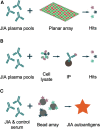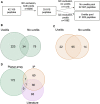Identification of novel autoantigens as potential biomarkers in juvenile idiopathic arthritis associated uveitis
- PMID: 36699287
- PMCID: PMC9869058
- DOI: 10.3389/fped.2022.1091308
Identification of novel autoantigens as potential biomarkers in juvenile idiopathic arthritis associated uveitis
Abstract
Background: Many children with juvenile idiopathic arthritis (JIA) have autoantibodies, targeting nuclear components (anti-nuclear antibodies, ANA). ANA in JIA is associated with uveitis, an eye inflammation which may cause permanent vision impairment if not detected and treated. However, ANA-testing is neither specific nor sensitive enough to be a clinically reliable predictor of uveitis risk, and the precise autoantigens targeted by ANA in JIA are largely unknown. If identified, specific autoantibodies highly associated with uveitis could be used as biomarkers to facilitate identification of JIA patients at risk.
Methods: Antibodies from six ANA-positive, oligoarticular JIA patients, with and without uveitis, were explored by two large-scale methods: (1) screening against 42,100 peptides on an autoimmunity profiling planar array, and (2) immunoprecipitations from cell lysates with antigen identification by mass spectrometry. Three hundred thirty-five peptide antigens, selected from proteins identified in the large-scale methods and the scientific literature were investigated using a bead-based array in a cohort of 56 patients with oligoarticular- or RF-negative polyarticular JIA, eight of which were having current or previous uveitis.
Results: In the planar array, reactivity was detected against 332 peptide antigens. The immunoprecipitations identified reactivity towards 131 proteins. Only two proteins were identified by both methods. In the bead-based array of selected peptide antigens, patients with uveitis had a generally higher autoreactivity, seen as higher median fluorescence intensity (MFI) across all antigens, compared to patients without uveitis. Reactivity towards 17 specific antigens was significantly higher in patients with uveitis compared to patients without uveitis. Hierarchical clustering revealed that patients with uveitis clustered together.
Conclusion: This study investigated autoantigens in JIA and uveitis, by combining two exploratory methods and confirmation in a targeted array. JIA patients with current or a history of uveitis had significantly higher reactivity towards 17 autoantigens and a generally higher autoreactivity compared to JIA patients without uveitis. Hierarchical clustering suggests that a combination of certain autoantibodies, rather than reactivity towards one specific antigen, is associated with uveitis. Our analysis of autoantibodies associated with uveitis in JIA could be a starting point for identification of prognostic biomarkers useful in JIA clinical care.
Keywords: anti nuclear antibody (ANA); autoantibodies; autoantigen; biomarker; juvenile idiopathic arthiritis; juvenile idiopathic arthiritis associated uveitis; uveitis.
© 2023 Arve-Butler, Mossberg, Kahn, Najibi, Berthold, Król, Månsson and Kahn.
Conflict of interest statement
The authors declare that the research was conducted in the absence of any commercial or financial relationships that could be construed as a potential conflict of interest.
Figures




Similar articles
-
Uveitis and anti nuclear antibody positivity in children with juvenile idiopathic arthritis.Indian Pediatr. 2004 Oct;41(10):1035-9. Indian Pediatr. 2004. PMID: 15523130
-
Identification of Ocular Autoantigens Associated With Juvenile Idiopathic Arthritis-Associated Uveitis.Front Immunol. 2019 Aug 6;10:1793. doi: 10.3389/fimmu.2019.01793. eCollection 2019. Front Immunol. 2019. PMID: 31447836 Free PMC article.
-
Prevalence and outcome of juvenile idiopathic arthritis-associated uveitis and relation to articular disease.J Rheumatol. 2007 May;34(5):1139-45. Epub 2007 Mar 1. J Rheumatol. 2007. PMID: 17343317
-
Disease of the year: juvenile idiopathic arthritis-associated uveitis--classification and diagnostic approach.Ocul Immunol Inflamm. 2014 Feb;22(1):56-63. doi: 10.3109/09273948.2013.871565. Epub 2014 Jan 10. Ocul Immunol Inflamm. 2014. PMID: 24410427 Review.
-
B Cells on the Stage of Inflammation in Juvenile Idiopathic Arthritis: Leading or Supporting Actors in Disease Pathogenesis?Front Med (Lausanne). 2022 Apr 4;9:851532. doi: 10.3389/fmed.2022.851532. eCollection 2022. Front Med (Lausanne). 2022. PMID: 35449805 Free PMC article. Review.
Cited by
-
A clearer vision: insights into juvenile idiopathic arthritis-associated uveitis.Proc (Bayl Univ Med Cent). 2024 Feb 8;37(2):303-311. doi: 10.1080/08998280.2024.2305567. eCollection 2024. Proc (Bayl Univ Med Cent). 2024. PMID: 38343470 Free PMC article.
-
14-3-3 Eta protein as a novel biomarker in early detection of uveitis in Egyptian juvenile idiopathic arthritis and rheumatoid arthritis patients: Diagnostic and prognostic value.Rheumatol Immunol Res. 2025 Jan 9;5(4):217-226. doi: 10.1515/rir-2024-0030. eCollection 2024 Dec. Rheumatol Immunol Res. 2025. PMID: 39802549 Free PMC article.
References
LinkOut - more resources
Full Text Sources

